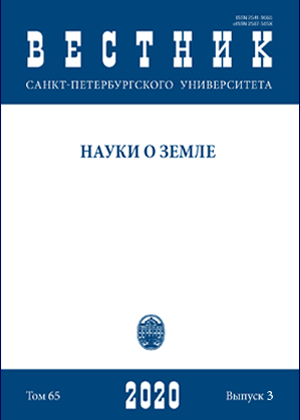Lithogeochemistry and depositional environments of sedimentary rocks of the upper Vendian and lower Cambrian of the North-West Baltic monocline
DOI:
https://doi.org/10.21638/spbu07.2020.310Abstract
A lithochemical and chemostratigraphic study of the boundary Upper Vendian–Lower Cambrian deposits of the Baltic monocline in the well sections of Leningrad Oblast and northeastern Estonia was carried out in the volume of the Redkino, Kotlin and Lontova horizons. Both common features and differences in the rock associations of individual horizons in different wells are revealed, which is a consequence of local variations of sedimentation conditions. The deposits of the Redkino horizon uncovered in the central and eastern parts of the region are characterized by a similar composition of rocks, represented by moderately deep-water sandy-clayey sediments of small thickness, formed in disoxidic and anoxic environments with pronounced processes of bacterial sulfate reduction. The deposits of the Kotlin horizon are represented by two groups of rocks. In the sections of wells in the east and west of Leningrad Oblast, a variety of sandy-siltstone rocks, representing coastalmarine sediments of oxidative conditions in the basin, predominate. In sections of the central part of the Baltic monocline (district of St. Petersburg), fine-grained deep-water disoxic and ferrigenous anoxic environments with a marked accumulation of siderite are common. Marine sandy-clay deposits of the Lontova horizon of the Lower Cambrian have similar lithochemical characteristics with the Kotlin deposits of the “eastern” and “western” sections of the territory, but they were formed under conditions of some oxygen deficiency (disoxic facies). Petrochemical analysis of core material showed that all the sediments studied belong to lithogenic sediments in which no presence of volcanic or pyrogenic material is observed. The formation of the sedimentary sequence of the Upper Vendian–Lower Cambrian of the Baltic monocline took place under the conditions of a passive continental regime with a gradual change of humid climatic conditions with semiarid ones.
Keywords:
lithogeochemistry, sedimentation conditions, terrigenous rocks, Upper Vendian, Lower Cambrian, Baltic monocline, East European platform
Downloads
Downloads
Published
How to Cite
Issue
Section
License
Articles of "Vestnik of Saint Petersburg University. Earth Sciences" are open access distributed under the terms of the License Agreement with Saint Petersburg State University, which permits to the authors unrestricted distribution and self-archiving free of charge.






